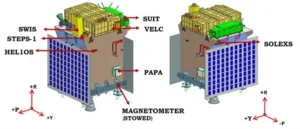Aditya L1: India’s First Solar Mission
Aditya L1 First Indian mission to study the Sun. The spacecraft will be placed in a halo orbit around Lagrange Point 1 (L1) in the Sun-Earth System, about 1.5 million kilometers from Earth. Aditya L1 scheduled to launch on September 2, 2023 at 11:50 am.
In space exploration, India has made tremendous progress in recent years, with efforts like Mars Orbiter Mission (Mangalyaan) and Chandrayaan1 , Chandrayaan2, Chandrayaan3 Mission to the Moon attracting global attention In the wake of this progress,Indian Space Research Organization (ISRO) and Set an ambitious goal: the Aditya L1 mission. The mission seeks to study the Sun and promises to provide valuable insights into the behavior of the nearest stars.
Named after the Hindu solar god ‘Aditya’, the Aditya L1 mission is India’s first dedicated solar mission. Its primary purpose is to observe the Sun, focusing primarily on the outer layer of the Sun, the corona. The corona is a part of the sun’s atmosphere that is millions of degrees hotter than the sun’s surface.
Main objectives:
Solar Corona Research
Monitoring solar activity
Space Weather Forecasting
Knowledge of the sun
Study of the Solar Wind
-The main goal of the Aditya L1 mission is to study the solar corona and understand its composition, temperature and the mechanisms that cause its intense heat.
-Solar Activity Monitoring monitors and predicts solar activity, such as solar flares and explosions, which can affect Earth’s space environment.
-Space Weather Forecasting To improve space weather forecasting for Earth-based satellites, astronauts, and even power grids.
– solar seismology, which studies the internal structure of the sun by observing its surface vibrations.
– Solar wind can affect Earth’s magnetosphere and have a significant impact on our planet’s climate.
To achieve these objectives, the Aditya L1 has been equipped with many scientific tools, e.g.
to capture images of the solar corona in visible light, allowing scientists to study its temperature and dynamics using the Visible Emission Line Coronagraph (VELC).
Sensitive to composition and temperature, the Solar Ultraviolet Imaging Telescope (SUIT) will capture images of the sun’s outer layer in the ultraviolet spectrum
The solar wind particle experiment (ASPEX) is being used to help scientists understand its effects on the Earth’s magnetosphere.
The Aditya L1 mission represents a major breakthrough for India in solar and space exploration. The mission promises to enhance our understanding of space weather, solar energy and its impact on our planet by studying our most important global neighbor, the Sun. As the mission continues, it has the potential to yield valuable insights that will benefit not only scientists but also the wider global community










